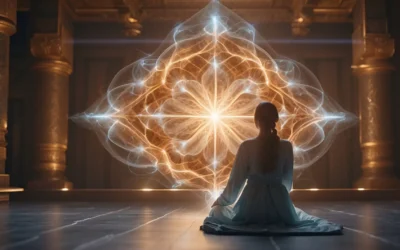Chakra meditation, an ancient practice rooted in the Indian spiritual tradition, focuses on balancing the chakras within our body’s energy system. By harnessing this technique, individuals aim to promote physical, emotional, and mental well-being. Through targeted meditation on specific chakras such as the root or throat chakra, practitioners seek to unlock a myriad of benefits. This holistic approach is believed to enhance overall vitality and inner harmony by aligning the body’s energy centers.
- Understanding Chakras and Their Functions
- History and Evolution of Chakra Meditation
- A Complete Guide to Chakra Meditation Techniques
- Step-by-Step Instructions for Chakra Meditation
- Deep “Box Breathing” Technique for Chakra Activation
- Exploring the Seven Chakras and Their Significance
- Incorporating Chakra Meditation into Daily Life
- Healing and Balancing Specific Chakras
- Conclusion on Chakra Meditation and Well-being
- Frequently Asked Questions
Understanding Chakras and Their Functions
The Seven Main Chakras
Chakra meditation is centered around the seven main chakras in the body, each associated with a specific location and color. These energy centers are aligned along the spine, starting from the base and extending to the crown of the head. For instance, the root chakra, located at the base of the spine, is linked to our sense of security and survival. Each chakra serves as a focal point for different aspects of our physical, emotional, and mental well-being.
The seven main chakras include:
- Root (Muladhara)
- Sacral (Swadhisthana)
- Solar Plexus (Manipura)
- Heart (Anahata)
- Throat (Vishuddha)
- Third Eye (Ajna)
- Crown (Sahasrara)
Functions of Each Chakra
Every chakra plays a crucial role in maintaining balance within various aspects of our being. For example, when focusing on chakra meditation, one might aim to enhance clarity by aligning their third eye chakra or work on fostering a sense of compassion through heart chakra activation. By understanding these functions, individuals can address specific needs within themselves through targeted meditation practices.
The functions can be summarized as follows:
- Root: Sense of security and stability
- Sacral: Creativity and emotional balance
- Solar Plexus: Personal power and self-esteem
- Heart: Love, compassion, and connection
- Throat: Communication and self-expression
- Third Eye: Intuition and clarity
- Crown: Spiritual awareness
Connection between Chakras and Overall Health
The state of our energy system impacts our overall health – physically, emotionally, and mentally – which is why balancing these energy centers is essential for holistic well-being.
History and Evolution of Chakra Meditation
Origins of Chakra Meditation
Chakra meditation has its roots in ancient Indian spiritual practices, particularly within the Hindu and Buddhist traditions. The concept of chakras as energy centers in the body dates back thousands of years in texts such as the Vedas and Upanishads. These early references describe chakras as vital points where subtle energy flows intersect. Practitioners believed that by balancing these energies through meditation, one could achieve physical, mental, and emotional well-being.
Chakra meditation techniques were developed to align and cleanse these energy centers, promoting harmony within the body and mind. As a result, this practice became an integral part of various spiritual disciplines like yoga and Ayurveda.
Evolution of Chakra Meditation Practices
Over time, chakra meditation evolved beyond its traditional origins to encompass a broader spectrum of beliefs and practices. It found its way into Western cultures during the 20th century through the influence of yoga teachers, scholars, and spiritual leaders who introduced these concepts to a global audience. This led to a fusion with other forms of meditative practices such as mindfulness and guided visualization.
In contemporary times, chakra meditation has become more accessible through workshops, online resources, and wellness retreats tailored for diverse audiences seeking holistic healing methods. Its evolution continues as modern practitioners adapt ancient techniques to suit their individual needs while integrating scientific research on mind-body connections.
Influence of Chakra Meditation in Different Cultures
The impact of chakra meditation extends beyond South Asian traditions; it has permeated various cultural landscapes worldwide. For instance,
- In Japan: Reiki incorporates principles akin to chakras for energy healing.
- In Western countries: Many individuals incorporate chakra balancing into their self-care routines.
- In holistic therapies: Therapists often use chakra-based approaches for emotional release or stress reduction.
A Complete Guide to Chakra Meditation Techniques
Exploring Different Techniques
Chakra meditation encompasses a variety of techniques that focus on balancing the body’s energy centers. These techniques include visualization, sound therapy, and mindfulness practices. Visualization involves picturing each chakra and its associated color in your mind’s eye to promote healing and balance. Sound therapy utilizes specific sounds or mantras linked to each chakra to facilitate alignment and harmony within the body. Mindfulness practices encourage individuals to bring their awareness to each chakra, fostering a deep sense of connection with their inner self.
Embracing these diverse tools allows practitioners to tailor their chakra meditation practice according to their preferences and needs. For instance, if someone is drawn more toward visual imagery, they may find visualization techniques particularly beneficial. On the other hand, those responsive to auditory stimuli might resonate better with sound therapy methods such as chanting or listening to specific frequencies associated with each chakra.
Chakra meditation can also incorporate the use of chakra crystals or stones to enhance the practice. Each chakra is associated with specific stones that are believed to help balance and align the energy centers. For example, amethyst is often linked to the crown chakra, while citrine is associated with the solar plexus chakra. By placing these crystals on the corresponding chakra points during meditation, practitioners aim to amplify the healing and balancing effects of their practice. The use of chakra crystals or stones adds another dimension to chakra meditation, providing a tangible and grounding element to the spiritual practice.
Importance of Consistency in Practice
Consistency plays a pivotal role in reaping the full benefits of chakra meditation. Regular practice not only enhances one’s understanding of the different techniques but also fosters a deeper connection with the body’s energy system over time. By consistently engaging in chakra meditation, individuals can gradually experience heightened awareness of imbalances within their energy centers and work towards restoring equilibrium through dedicated practice.
Step-by-Step Instructions for Chakra Meditation
Basic Steps
To begin chakra meditation, find a quiet, comfortable spot. Sit or lie down, ensuring your spine is straight for optimal energy flow. Close your eyes and take deep breaths to relax. Visualize each chakra starting from the root up to the crown of your head.
Focus on the specific color associated with each chakra while breathing deeply. For instance, envision red for the root chakra, orange for sacral, yellow for solar plexus, green for heart, blue for throat, indigo for third eye, and violet or white light for crown.
Imagine a spinning wheel of energy at each corresponding location in your body. As you concentrate on these points and colors during deep breaths, visualize any blockages dissolving as the energy flows freely through each chakra.
Tips and Environment
For beginners practicing chakra meditation, it’s essential to start with short sessions before gradually increasing the duration as comfort levels rise. Playing soft music or using aromatherapy can enhance relaxation during meditation.
Creating a conducive environment involves minimizing distractions by turning off electronic devices and informing others not to disturb you during this time. Utilizing dim lighting or candles can also aid in setting a tranquil atmosphere that promotes focus and calmness.
Deep “Box Breathing” Technique for Chakra Activation
Box Breathing Technique
The box breathing technique, also known as square breathing, involves taking slow and deep breaths. It consists of four equal parts: inhaling, holding the breath, exhaling, and holding again. This pattern creates a square-like shape when visualized on a graph or in the mind. The purpose is to regulate the breath and bring focus to it.
Box breathing enhances chakra activation by promoting relaxation and mindfulness. When practiced during chakra meditation, this technique helps clear any energy blockages within the body’s chakras. By regulating the flow of breath, box breathing ensures that each chakra receives an adequate supply of oxygenated blood and energy.
Incorporating Box Breathing
Incorporating box breathing into chakra meditation practice involves integrating it into the overall meditation routine. Begin by finding a comfortable seated position with a straight spine. Close your eyes and start focusing on your natural breath rhythm before transitioning into box breathing.
As you progress through each stage of box breathing—inhale, hold, exhale, hold—imagine directing your breath towards each specific chakra point in your body. For example:
- Inhale while envisioning air flowing towards the root chakra at the base of your spine.
- Hold while visualizing energy accumulating at this point.
- Exhale as if releasing any negativity or tension from this area.
- Hold again while feeling a sense of balance restored to this particular chakra.
Exploring the Seven Chakras and Their Significance
Overview of Each Chakra
The chakras are energy centers in the body, each associated with specific characteristics and significance. The first chakra is the root chakra, representing our foundation and feeling of being grounded. Moving up, we have the sacral chakra, linked to our ability to accept others and new experiences. Then comes the solar plexus chakra, governing our self-confidence and control.
Continuing on, we reach the heart chakra, responsible for love, compassion, and inner peace. Next is the throat chakra which relates to communication and self-expression. Moving further up is the third eye chakra that enhances intuition and spiritual connection. Finally, there’s the crown chakra at the top of your head symbolizing your connection with a higher consciousness.
Each of these chakras plays a crucial role in maintaining overall well-being.
Unique Characteristics and Significance
Every chakra has its unique attributes affecting different aspects of our physical as well as emotional well-being. For instance, an imbalance in your root or first chakra can lead to feelings of insecurity or anxiety while disrupting your sense of stability.
Similarly, imbalances in other chakras can manifest as various issues – from difficulty expressing oneself (throat), and lack of empathy (heart), to feeling disconnected spiritually (crown). By understanding their individual significance you can identify areas for personal growth through targeted meditation practices aimed at restoring balance within each energy center.
Incorporating Chakra Meditation into Daily Life
Consistent Practice
Incorporating chakra meditation into your daily routine can be as simple as starting the day with a few minutes of focused breathing and visualization. Throughout the day, you can take short breaks for quick meditation practice, such as focusing on each chakra’s associated color and its specific area in the body.
Consistency is key. One effective way is to link your meditation practice with everyday activities, like practicing mindful eating or incorporating brief moments of stillness during regular tasks.
Benefits of Regular Practice
Engaging in chakra meditation throughout the day promotes a sense of groundedness and balance. It helps align the energy centers within the body, leading to improved overall well-being. By infusing your daily life with conscious living and mindfulness practices, you create space for inner peace amidst life’s demands.
Regular engagement in chakra-based mindfulness activities supports a holistic approach to wellness by addressing both physical and mental aspects. This integrated approach fosters harmony between mind, body, and spirit while navigating through various challenges encountered daily.
Overcoming Challenges
One common challenge in maintaining a regular meditation practice is finding time amidst busy schedules. However, identifying small pockets of time throughout the day for brief chakra-focused exercises can help overcome this obstacle.
Another challenge involves staying present during these practices amid distractions. To address this issue, it’s essential to gently guide your focus back to the present moment whenever your mind wanders during chakra meditation, fostering resilience against everyday disruptions.
Healing and Balancing Specific Chakras
Recognizing Imbalance
Each chakra in the body is associated with specific emotions, organs, and functions. Understanding the signs of imbalance in a particular chakra is crucial for effective healing. For example, an individual experiencing fear or insecurity may have an imbalanced root chakra, while someone struggling with self-expression may have issues with their throat chakra.
Recognizing these signs can help individuals identify which chakras need attention and balancing. Physical symptoms such as digestive problems or chronic fatigue could indicate blockages in certain energy centers. Emotional indicators like anxiety or mood swings might also point to specific areas that require healing.
Seeking Professional Guidance
While there are various techniques for healing and balancing individual chakras, it’s essential to seek professional guidance when needed. Trained practitioners can provide personalized insights into addressing specific chakra imbalances through practices like meditation, yoga, or energy work.
Professional support ensures that individuals receive tailored care based on their unique needs. Whether attending specialized retreats focusing on chakra healing or seeking one-on-one sessions with experts, professional guidance enhances the effectiveness of addressing chakra imbalances.
Conclusion on Chakra Meditation and Well-being
You’ve now journeyed through the intricate web of chakras, exploring their profound impact on your well-being. By understanding the functions, techniques, and significance of chakra meditation, you’ve gained valuable insights into how to incorporate this ancient practice into your daily life. As you delve deeper into the healing and balancing of specific chakras, remember that the key to unlocking their potential lies within your dedication and mindfulness.
Take the next step in your chakra meditation practice by immersing yourself in the experience. Whether it’s through guided meditation sessions, self-reflection, or seeking out expert advice, continue to explore and nurture your chakras. Embrace this transformative journey with an open heart and a willingness to connect with your inner self.
Frequently Asked Questions
How can chakra meditation benefit my well-being?
Chakra meditation can enhance your overall well-being by promoting balance and harmony within the body, mind, and spirit. It helps to release stress, increase self-awareness, and foster a sense of inner peace.
What are some practical techniques for incorporating chakra meditation into daily life?
Simple practices like mindfulness exercises, deep breathing techniques, visualization, and yoga can be integrated into your daily routine to support chakra meditation. These activities help in grounding yourself and maintaining energetic balance throughout the day.
Is it necessary to have prior experience with meditation to practice chakra meditation?
No prior experience is required to practice chakra meditation. Beginners can start with basic techniques such as focused breathing or guided visualization. With consistent practice and an open mindset, anyone can benefit from this ancient form of healing.
Can specific physical symptoms indicate imbalances in certain chakras?
Yes, physical discomfort or ailments in particular areas of the body may suggest imbalances in corresponding chakras. For example, recurring throat issues could indicate a blockage in the throat (Vishuddha) chakra that might require attention through targeted meditative practices.
How often should one engage in chakra meditation for noticeable effects?
Consistent practice is key; aim for at least 10-15 minutes of daily sessions to experience tangible benefits over time. Regularity fosters a deeper connection with your energy centers while allowing you to observe gradual improvements in mental clarity and emotional stability.











